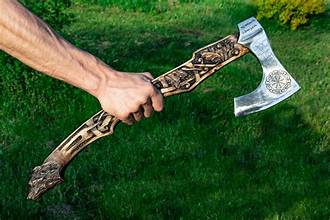
Weapons of the Norse: A Comprehensive Exploration of Viking Arms, with Emphasis on the Formidable Viking Axe
The Vikings, seafaring warriors of the North, were renowned not only for their daring exploits but also for their mastery in crafting and wielding an array of formidable weapons. This article serves as a detailed exploration of Viking arms, with a spotlight on the iconic Viking axe—a symbol of both practicality and martial prowess.
The Sword: A Status Symbol:
The Viking sword, with its distinctive hilt and double-edged blade, was not only a weapon of war but also a status symbol. Typically reserved for the elite, swords were adorned with intricate designs, runes, and symbols, reflecting the wealth and prestige of the warrior wielding it.
Spears: Versatile and Practical:
The spear was a ubiquitous weapon in the Viking arsenal, prized for its versatility. Used both in melee combat and thrown with deadly accuracy, spears were favored by Vikings for their effectiveness on the battlefield. The simplicity of their design allowed for mass production, ensuring widespread use.
Battle Axes: The Precursor to the Viking Axe:
Before delving into the Norse axe, it’s essential to recognize the importance of the battle axe in Norse weaponry. Often featuring a single, broad blade with a wooden shaft, battle axes were wielded with both hands and served as powerful cleaving tools on the battlefield.
Viking Axes: A Dual-Purpose Marvel:
The Viking axe, with its double-edged blade and various designs, was a hallmark of Norse weaponry. Its dual functionality as both a tool for daily life and a devastating weapon in battle showcased the Vikings’ practical approach to armament. The bearded axe, characterized by a hook-like extension, was particularly favored for its versatility.
The Dane Axe: A Weapon of Choice:
The Dane axe, distinguished by its long handle and broad blade, was a favored weapon among Viking warriors. Known for its ability to deliver powerful sweeping strikes, the Dane axe was particularly effective in close-quarters combat, making it a weapon of choice for many Norse fighters.
Bows and Arrows: Ranged Precision:
While not as prevalent as other weapons, bows and arrows were employed by skilled archers among the Vikings. Ranged attacks provided strategic advantages in both hunting and warfare, allowing Vikings to engage enemies from a distance.
Seaxes: The Viking Utility Knife:
The seax, a single-edged utility knife, served as a multipurpose tool for Vikings. Worn at the waist, the seax was useful for everyday tasks, from cutting food to crafting, and could also be wielded as a close-quarters weapon when needed.
Raiding and Defensive Strategies:
The selection of weapons in the Viking repertoire was influenced by the nature of their expeditions and their defensive needs. While raiding parties favored mobility and versatility, defensive structures often saw the use of weapons like long spears and axes with extended reach.
Legacy and Modern Resurgence:
The legacy of Viking weapons, including the formidable Viking axe, endures in popular culture, historical reenactments, and the crafting of replicas. Modern enthusiasts and historians alike continue to explore the craftsmanship, design, and martial significance of these iconic weapons.
The Weaponry of a Seafaring People:
From the mighty Viking axe to the elegant sword, the weaponry of the Norse reflects not only a commitment to martial strength but also a pragmatic approach to tools for daily life. As we delve into the arms of the Vikings, we uncover not just instruments of war but artifacts that speak to the ingenuity, craftsmanship, and indomitable spirit of a seafaring people who left an enduring mark on history.


